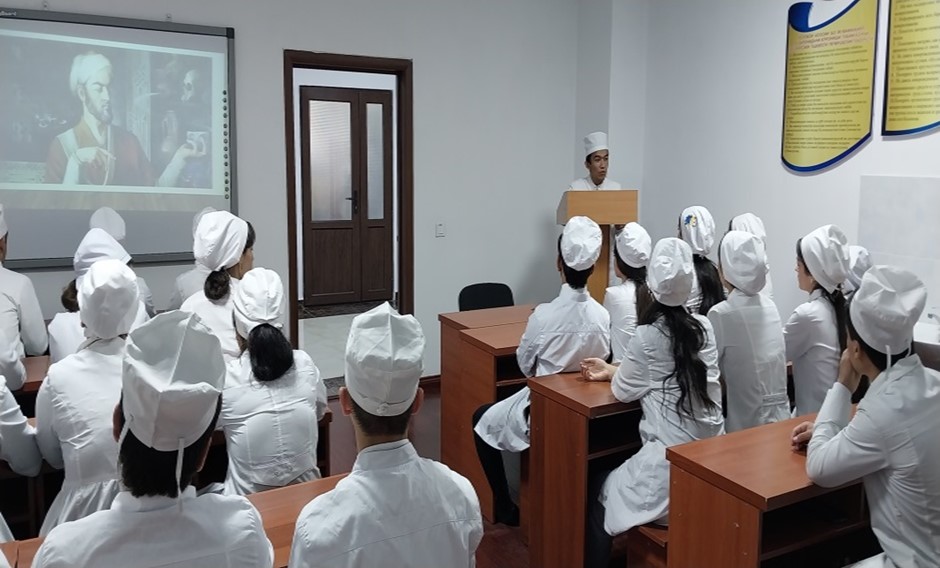AVICENNA - GENIUS PERSIAN AND TAJIK SCIENTIST, PHYSICIAN, PHILOSOPHER, POET
On October 18, 2023 at the department of propaedeutics of children's diseases of the State Educational Institution “Avicenna Tajik State Medical University” under the guidance of candidate of medical sciences, associate professor Abdullaeva N.A. and assistant Ashurova N.P. was held an open lesson on the theme: “Avicenna - Persian-Tajik poet, philosopher and doctor” with the participation of the department staff and students of 1, 2 and 7 groups of the 3rd year of pediatric faculty.
Ibn Sina, better known as Avicenna, is among the people who left a bright mark in the history of mankind. He is known as a physician, philosopher, mathematician, musician, poet, great scientist, whose works are left in 29 spheres of science. It is difficult to enumerate all his talents. Sometimes nature shows its miracles, so that we do not forget about its power, and then such geniuses as Avicenna are born. It is difficult to find a personality as interesting and versatile as Ibn Sina. Abu Ali Hussein ibn Abdullah ibn Hasan ibn Ali ibn Sina, known as Abu Ali ibn Sina, is one of the greatest scientists and physicians of the Middle Ages in the world; a scientist, chemist, geologist, logician, mathematician, physicist, psychologist, philosopher and a great Persian-Tajik educator. He was born in 980 in the Samanid state, in the settlement of Afshana. His father, an employee of the Samanid administration, was in charge of Avicenna's primary education. It was he who awakened in the boy a craving for knowledge. From a young age Avicenna showed remarkable abilities: at the age of 10 he studied the grammatical structure of Persian and Arabic languages, the doctrine of poetic art and, most strikingly, knew the Koran by heart. At the age of 11, the future philosopher and physician was sent to Bukhara to study the basics of fiqh - Muslim law. Abu Abdallah Natili was a scholar under whose guidance the young Avicenna studied logic, philosophy, the doctrine of celestial bodies and the science of spatial forms. Soon the young man surpassed his teacher and from the age of 14 began to study himself, at the same time he first read Aristotle's "Metaphysics". As the sage later wrote, he was helped to understand Aristotle's works by al-Farabi's book with explanations to "Metaphysics". Ibn Sina became interested in medicine at a young age. The 16-year-old doctor was invited to treat the Emir who ruled Bukhara. Ibn Sina conducted examinations and observations of many patients, gaining experience and improving his knowledge in practice. At the age of 18, Avicenna was already known throughout Bukhara as an accomplished scientist and talented physician. Four years later, he traveled to Gurganj, a city that was the capital of Khorezm. There he was able to improve his knowledge and gained valuable skills.
Most of Ibn Sina's life was devoted to philosophy. It should be noted a special contribution to medicine of the scientist. It is about the work "Canon of Medical Science". The work for the first time describes microscopic, inaccessible to the eye organisms that cause diseases in people. Also in the Canon, Avicenna described many diseases (including the first to list the signs of stomach ulcers and diabetes) and medicines. The treatise is known as the major medical work of the Middle Ages. Ibn Sina created many scientific works in the form of poems. Lyrical poetry was also not alien to the scientist - he wrote rubai. In the history of Persian-Tajik literature Abu Ali ibn Sina is recognized as a great poet, and poems are the most important part of his literary work. Odes and ghazals of the poet are mystical and moral. The poet's wise thoughts are vividly reflected in his poems and reveal the poet's social attitude and personality. Ibn Sina wrote more than 450 treatises in various fields of science, of which only 240 have survived to our time. These treatises cover many fields of science, notably 150 of them in the field of philosophy and over 40 in the field of medicine. The most brilliant of his books is the Canon of Medicine. But other works have also entered the history, became classics - "The Book of Salvation", "The Book of Knowledge", "The Book of Instructions and Notes", "The Book of Fair Trial"... The number of all works of the philosopher varies in different sources. In Arabic literature there are about ten works of the philosopher (astronomy, chemistry, alchemy, etc.) in preserved incomplete manuscript form. Now they are in libraries in different countries of the world. His most famous works are Al-Shifa and Al-Qanunu fi-t-t-tib, which are among the largest specialized and philosophical encyclopedias and were taught in European universities until the 19th century.
Ibn Sina was a truly great man: thanks to his works, many lives were saved, and science went far ahead. His treatises are still relevant today, and his innovative ideas were far ahead of the development of science in the Middle Ages.
Department of propaedeutics of children's diseases
translated
Ruzimuhammad Ismoilov

